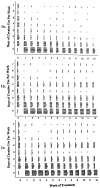Intention-to-treat meets missing data: implications of alternate strategies for analyzing clinical trials data
- PMID: 12234641
- PMCID: PMC3651592
- DOI: 10.1016/s0376-8716(02)00111-4
Intention-to-treat meets missing data: implications of alternate strategies for analyzing clinical trials data
Abstract
True intention-to-treat analyses are rare in reports of randomized clinical trials. To highlight the complex issues that arise in conducting and interpreting data from intention-to-treat analyses in studies with substantial levels of protocol violation (e.g. attrition, noncompliance, or withdrawal of participants), data from a clinical trial of treatment for cocaine dependence were analyzed using three strategies to manage missing data: Strategy 1 addressed the effectiveness of treatments based on data collected from participants up to the point of dropout. Strategy 2 addressed the effectiveness of treatments based on data from the full intended duration of the protocol including data collected after participant dropout. The third strategy used a more novel approach, which used an intention-to-treat strategy for the full duration of the trial and the full sample, but also evaluated the effect of treatment retention outcomes by including an independent variable to reflect active treatment retention as a time-varying covariate. Conclusions about the relative efficacy of the study treatments varied to some extent depending on the analytic strategy used. These findings suggest that investigators should make every effort to conduct intent-to-treat analyses, but also to make use of multiple analytic strategies to fully understand the effects of the treatments studied. Moreover, regardless of the strategy used, investigators should clearly describe their handling of data from participants who violate the protocol.
Figures


References
-
- Adetugbo K, Williams H. How well are randomized controlled trials reported in the dermatology literature? Arch Dermatol. 2000;136 (3):381–385. - PubMed
-
- Begg CB, Cho MK, Eastwood S, Horton R, Moher D, Olkin I, Pitkin R, Rennie D, Schultz KF, Simel D, Stroup DF. Improving the quality of reporting of randomized clinical trials: the CONSORT statement. JAMA. 1996;276:637–639. - PubMed
-
- Bollini P, Pampallona S, Tibaldi G, Kupelnick B, Munizza C. Effectiveness of antidepressants. Meta-analysis of dose– effect relationships in randomized clinical trials. Br J Psych. 1999;174:297–303. - PubMed
-
- Bryk AS, Raudenbush SW. Application of hierarchical linear models to assessing change. Psychol Bull. 1992;101:147–158.
-
- Carroll KM. A Cognitive-Behavioral Approach: Treating Cocaine Addiction (NIH Publication 98-4308) NIDA; Rockville, MD: 1998.
Publication types
MeSH terms
Grants and funding
LinkOut - more resources
Full Text Sources

